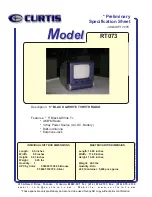
WI-25023
13
PAIN MANAGEMENT SYSTEMS
Generator Service Manual
5.2 Rear Panel Displays, Controls, and Connections
Note: The picture above depicts a typical PMG 4.1 display. The display may differ per PMG
version.
Descriptions of rear panel features and their functions are given below. Please refer to Figure
5-2 for corresponding locations on the rear panel.
1.
Volume Adjustment:
This knob adjusts the volume of the system’s audio output.
2.
Device Label:
This label indicates the model number of the Generator and includes
contact information for Halyard Health ( Kimberly-Clark). The unique serial number
of the Generator is marked on this label.
3.
Software Version Label:
This label indicates the PMG software version.
4.
AC MAINS SWITCH:
This switch controls the initial AC power input to the system,
and is part of the power entry module, which integrates the AC power inlet and
Fuse Drawer.
5.
Fuse Drawer:
The orientation of the fuse drawer, in conjunction with the AC
CONFIGURATION SWITCH, determines the AC input voltage range (100-120V~
or 220-240V~). For each voltage setting the proper, corresponding fuses must
be used, as indicated in the rear panel labeling. (Applies only to v4.1 and older
versions).
6.
AC CONFIGURATION SWITCH:
The orientation of this switch, in conjunction
with the Fuse Drawer, determines the AC input voltage range (100-120V~ or 220-
240V~). Do not change the position of the voltage selector while the system is
plugged in. (Applies only to v4.1 and older versions).
7.
Equipotential Ground Connection:
This connector is attached to the chassis/
earth ground. It is intended for earth reference connection in environments where
equipotential ground cabling is used.
8.
Fan:
A brushless DC fan is used to exhaust warm air from the Generator. The
direction of airflow is outward from the rear panel.
9.
FOOTSWITCH Connection:
This pneumatic barb connects to the hose of the
pneumatic footswitch. Like the OUTPUT ON/OFF switch, the FOOTSWITCH
controls stimulus output in the STIMULATION modes and controls RF output in
the LESION, COOLED RF, TRANSDISCAL, RFA and IDL modes. The action of the
FOOTSWITCH differs from the OUTPUT ON/OFF switch: the FOOTSWITCH must
be held down to continue delivery of stimulus pulses or RF energy.
10.
RS-232 Connection:
This is an isolated connection to a standard 9-pin COM
port. It is provided for passive data acquisition, and cannot be used to control the
system.
11.
RJ45 Connector:
Connection to be used by authorized service personnel only.
12.
Pump Module Interface Connector:
For attachment of authorized cooling pump
unit only.
Note: See user manual for your specific generator version














































